Canada’s Geothermal Energy Update in 2023
Abstract
1. Introduction
2. Geothermal Regulatory Frameworks and Acts
2.1. British Columbia
2.1.1. Geothermal Resource Definition
2.1.2. Summary of Resource Tenure
- Resource is governed by fluid temperature.
- Multicommodity extraction is not permitted (e.g., hydrocarbons and/or mineral commodities, like lithium in brine).
- Rights are granted via public tender.
- Lease is one “Block” (defined by the Petroleum and Natural Gas Grid Regulation; approximately 136 km2).
- Rights are exclusive to a single owner.
2.2. Alberta
2.2.1. Geothermal Resource Definition
2.2.2. Summary of Resource Tenure
- Resource is governed by heat.
- Multicommodity extraction is permitted (but appropriate rights must be held, such as petroleum and natural gas (PNG) rights for hydrocarbon extraction).
- Rights are granted via application.
- Lease is nine sections, all of which must be laterally or diagonally adjoining.
- Rights are non-exclusive to a single owner (i.e., the current legislation has not defined how multiple geothermal operators may operate in a single locality; this is seen as a major failing of Bill 36 [4]).
2.3. Saskatchewan
2.3.1. Geothermal Resource Definition
2.3.2. Summary of Resource Tenure
- Resource is governed by pore space.
- Multicommodity extraction is not permitted.
- Rights are granted at government discretion.
- Lease’s size is not defined.
- Rights are exclusive to a single owner.
2.4. Quebec
2.5. Nova Scotia
2.5.1. Geothermal Resource Definition
2.5.2. Summary of Resource Tenure
- All minerals are reserved for the Crown.
- A “geothermal resource area” is designated by the Governor in Council.
- A royalty regime is provided for mineral resources.
2.6. Yukon
2.7. Northwest Territories (NWT)
2.8. Other Jurisdictions
3. Province and Territory Updates
3.1. British Columbia
3.1.1. Mount Meager
3.1.2. Tu Deh-Kah (TDK)
3.1.3. Kitselas Geothermal
3.1.4. Kaska Dena
3.2. Alberta
3.2.1. Novus Earth Energy
3.2.2. Alberta No. 1
3.2.3. FutEra Power
3.2.4. Eavor Technologies Inc. (Eavor)
3.3. Saskatchewan
Deep Earth Energy Production Corporation
3.4. Quebec
3.5. Nova Scotia
3.6. Yukon
Yukon Geological Survey Research
3.7. Northwest Territories (NWT)
3.7.1. Fort Liard
3.7.2. NTGS: Liard Basin Geothermal Reservoir Characterization
3.7.3. NTGS: South Slave Geothermal Potential
3.7.4. NTGS: Con Mine
3.8. Nunavut
4. Academic Research
4.1. Geothermal Research and Programs at Canadian Universities
4.2. University of Calgary
4.3. University of Alberta
4.3.1. Western Canada Sedimentary Basin (WCSB)
4.3.2. Canadian Cordillera
4.3.3. Northern Canada
4.3.4. Socio-Economic Studies
4.4. Institut National de la Recherche Scientifique (INRS)
4.5. Polytechnique Montreal
4.6. Geological Survey of Canada (GSC)
5. Conclusions
Author Contributions
Funding
Data Availability Statement
Conflicts of Interest
Abbreviations
| AE | Arthabaska-Erable |
| AER | Alberta Energy Regulator |
| BTES | Borehole Thermal Energy Storage |
| CEA | Closed Environment Agriculture |
| COE | Cost of Energy |
| CPD | Curie Point Depth |
| DBHEs | Deep Borehole Heat Exchangers |
| DEEP | Deep Earth Energy Production |
| ERPP | Emerging Renewables Power Program |
| EGS | Enhanced Geothermal System |
| FNFN | Fort Nelson First Nation |
| GSC | Geological Survey of Canada |
| GBC | Geoscience British Columbia |
| GeoS | Geothermal Systems Research |
| GNWT | Government of Northwest Territories |
| GHG | Greenhouse Gas |
| GSHPs | Ground Source Heat Pumps |
| IODI | Indigenous Off-Diesel Initiative |
| IREQ | Institut de recherche d’Hydro-Quebec |
| INRS | Institut national de la recherche scientifique |
| LOG | Laboratoire Ouvert de Géothermie |
| NSERC | National Science and Engineering Council of Canada |
| NRCan | Natural Resources Canada |
| NWT | Northwest Territories |
| NTGS | Northwest Territories Geological Survey |
| ORC | Organic Rankine Cycle |
| PCPs | Permanent Column Wells |
| PNG | Petroleum and Natural Gas |
| PTRC | Petroleum Technology Research Centre |
| PV | Photovoltaic |
| R&D | Research and Development |
| RD&I | Research, Development, and Innovation |
| SOM | Southeast of Montreal |
| SEISE | Sustainable Energy and Infrastructure Systems Engineering |
| TRTs | Thermal Response Tests |
| TUG | Tight Unconventional Gas |
| TDK | Tu Deh-Kah |
| TVD | True Vertical Depth |
| WISE | Waterloo Institute for Sustainable Energy |
| WCSB | Western Canada Sedimentary Basin |
| YGS | Yukon Geological Survey |
References
- Dehghani-Sanij, A.R.; Bahadori, M.N. Ice-Houses: Energy, Architecture and Sustainability; Elsevier: Exeter Devon, UK; Academic Press: Cambridge, MA, USA, 2021. [Google Scholar]
- Dehghani-Sanij, A.R.; Al-Haq, A.; Bastian, J.; Luehr, G.; Nathwani, J.; Dusseault, M.B.; Leonenko, Y. Assessment of current developments and future prospects of wind energy in Canada. Sustain. Energy Technol. Assess. 2022, 50, 101819. [Google Scholar] [CrossRef]
- Hickson, C.; Raymond, J.; Dusseault, M.; Fraser, T.; Huang, K.; Marcia, K.; Miranda, M.; Poux, B.; Fiess, K.; Ferguson, G.; et al. Geothermal Energy in Canada–Times Are “a Changing”. In Proceedings of the 44th Geothermal Resources Council, Reno, Nevada, NY, USA, 18–21 October 2020. [Google Scholar]
- Hickson, C.; Hubbard, B.; Smejkal, E. Geothermal in Alberta–The importance of creating a regulatory environment conducive to supporting the growth of a geothermal industry. In Proceedings of the GeoConvention, Calgary, AB, Canada, 20–22 June 2022. [Google Scholar]
- Hickson, C.; Hubbard, B.; Smejkal, E. Geothermal in NWT–Regulatory Considerations. In Proceedings of the Yellowknife Geoscience Forum, Yellowknife, NT, Canada, 15–17 November 2022. [Google Scholar]
- Gascuel, V.; Pasquier, L.-C.; Raymond, J.; Hénault-Ethier, L. Mémoire de l’INRS–Projet de Loi 21–Pour L’amélioration de la Loi pour Mettre fin á la Recherche et á la Production D’hydrocarbures en Soutenant la Mise en Valeur Durable des Réservoirs Souterrains; Déposé dans le cadre des consultations de la CAPERN au sujet du projet de loi 21 «Loi visant principalement à mettre fin à la recherche et à la production d’hydrocarbures ainsi qu’au financement public de ces activités; Institut National de la Recherche Scientifique: Quebec City, QC, Canada, 2022; Available online: https://inrs.ca/wp-content/uploads/INRS_2022_Memoire-PL21.pdf (accessed on 5 April 2024).
- Holroyd, P.; Dagg, J. Building a Regulatory Framework for Geothermal Energy Development in the NWT. 2011. Available online: https://www.gov.nt.ca/sites/ecc/files/building_a_regulatory_framework_for_geothermal_in_the_nwt.pdf (accessed on 5 April 2024).
- Fairbank, B.D.; Faulkner, R.L. Geothermal Resource of British Columbia; Open File 2526; Geological Survey of Canada: Ottawa, ON, Canada, 1992. [Google Scholar]
- Kerr Wood Leidal. An Assessment of the Economic Viability of Selected Geothermal Resources in British Columbia Geoscience; Report 2015-11; Geoscience BC: Vancouver, BC, Canada, 2015. [Google Scholar]
- Hickson, C.; Proenza, Y.; Huttrer, G.; Yehia, R.; Majorowicz, J.; Lund, J.; Boyd, T.; Woodsworth, G.; Kunkel, T.; Moore, M.; et al. Direct Use Geothermal Resources in British Columbia, Section a Summary of Findings; Report 2016-07; Geoscience BC: Vancouver, BC, Canada, 2016. [Google Scholar]
- Geoscience BC. Garibaldi Geothermal Volcanic Belt Assessment Project. 2022. Available online: http://www.geosciencebc.com/projects/2018-004/ (accessed on 21 November 2023).
- Grasby, S.E.; Calahorrano-Di Patre, A.; Chen, Z.; Dettmer, J.; Gilbert, H.; Hanneson, C.; Harris, M.; Leiter, S.; Liu, J.; Muhammad, M.; et al. Geothermal resource potential of the Garibaldi volcanic belt, southwestern British Columbia (part of NTS 092J): Phase 2. In Geoscience BC Summary of Activities 2021: Energy and Water; Report 2022-02; Geoscience BC: Vancouver, BC, Canada, 2022. [Google Scholar]
- Meager Creek Development Corporation: Meager Creek Geothermal Project—A Mountain of Clean Energy. 2022. Available online: https://meagercreek.ca/ (accessed on 9 December 2022).
- Barkley Project Group: Map Created In-House at Barkley Using ArcGIS in 2022. 2022.
- Kitselas Geothermal Inc. Kitselas Geothermal-Geothermal Energy as Fuel for Reconciliation. 2022. Available online: https://www.kitselasgeo.ca/ (accessed on 9 December 2022).
- Grasby, S.E.; Allen, D.M.; Bell, S.; Chen, Z.; Ferguson, G.; Jessop, A.; Kelman, M.; Ko, M.; Majorowicz, J.; Moore, M.; et al. Geothermal Energy Resource Potential of Canada; Open File 6913; Geological Survey of Canada: Ottawa, ON, Canada, 2012.
- Witter, J.B. Early-Stage Exploration for Geothermal Energy Resources along the Denali Fault near Duke River, Yukon; Open File 2020-3; Yukon Geological Survey: Whitehorse, YT, USA, 2020.
- Hickson, C.; Kumataka, M.; Akto, P.; Cotterill, P.; Benoit, D.; Eccles, R.; Colombina, M.; Collins, S. Alberta No. 1: The province’s first electrical geothermal project. In Proceedings of the World Geothermal Congress, Reykjavik, Iceland, 24–27 October 2021. [Google Scholar]
- Huang, K.; Champollion, Y.; Hickson, C. Preliminary Results and New Insights from a Deep Temperature Log in the Western Canada Sedimentary Basin. In Proceedings of the 45th GRC Transactions, San Diego, CA, USA, 3–6 October 2021. [Google Scholar]
- Hickson, C.; Smejkal, E.; Rathbone, J. Geoexchange to Deep Conventional Geothermal Energy Extraction Technology Comparison. In Proceedings of the GeoConvention, Calgary, AB, Canada, 20–22 June 2022. [Google Scholar]
- Bédard, K.; Comeau, F.-A.; Millet, E.; Raymond, J.; Malo, M.; Gloaguen, E. Évaluation des Ressources Géothermiques du Bassin des Basses-Terres du Saint-Laurent (No. 1659); Institut National de la Recherche Scientifique-Centre Eau Terre Environnement: Québec City, QC, Canada, 2016. [Google Scholar]
- Richard, M.-A.; Giroux, B.; Gosselin, L.; Kendall, J.; Malo, M.; Mathieu-Potvin, F.; Minea, V.; Raymond, J. Intégration de la Géothermie Profonde Dans le Portefeuille Énergétique Canadien; IREQ-2017-0032; Hydro-Quebec: Montreal, QC, USA, 2016. [Google Scholar]
- Bédard, K.; Comeau, F.-A.; Raymond, J.; Gloaguen, E.; Malo, M.; Richard, M.-A. Deep geothermal resource assessment of the St. Lawrence Lowlands sedimentary basin (Québec) based on 3D regional geological modelling. Geomech. Geophys. Geo-Energy Geo-Resour. 2020, 6, 46. [Google Scholar] [CrossRef]
- Giordano, N.; Raymond, J. Field Report and Monitoring Plan of the Ground Source Heat Pump System for the Community Swimming pool in Kuujjuaq (Nunavik, Canada); Rapport de recherche R2007; Institut National de la Recherche Scientifique-Centre Eau Terre Environnement: Québec City, QC, Canada, 2020. [Google Scholar]
- Geotherma Solutions Inc. Thermal Response Test and Assessment of the Shallow Geothermal Potential at the Kuujjuaq Forum, Nunavik, Québec; Geotherma Solutions Inc.: Québec City, QC, Canada, 2022. [Google Scholar]
- Miranda, M.M.; Raymond, J. Assessing Kuujjuaq’s (Nunavik, Canada) Deep Geothermal Energy Potential; Rapport de recherche R2109; Institut National de la Recherche Scientifique-Centre Eau Terre Environnement: Québec City, QC, Canada, 2022. [Google Scholar]
- Jessop, A. Geothermal energy from old mines at Springhill, Nova Scotia, Canada. In Proceedings of the World Geothermal Congress, Florence, Italy, 18–31 May 1995. [Google Scholar]
- SaltWire. Concept Design for Springhill Geothermal Business Park Underway. 2019. Available online: https://www.saltwire.com/atlantic-canada/federal-election/concept-design-for-springhill-geothermal-business-park-underway-336905/ (accessed on 25 November 2022).
- Nova Scotia: Geothermal Energy-Current Activity. 2022. Available online: https://energy.novascotia.ca/renewables/geothermal-energy/current-activity (accessed on 24 November 2022).
- Comeau, F.-A.; Séjourné, S.; Raymond, J. Assessment of Geothermal Resources in Onshore Nova Scotia; Rapport de Recherche R2002; Institut National de la Recherche Scientifique-Centre Eau Terre Environnement: Québec City, QC, Canada, 2020. [Google Scholar]
- Malone, L. Direct Use of Geothermal Heat in Nova Scotia, Dunsky, Montreal. 2021. Available online: https://netzeroatlantic.ca/sites/default/files/2022-11/OERA%20Direct%20Use%20of%20Geothermal%20Heat%20in%20Nova%20Scotia_Final%20Report%20%281%29.pdf (accessed on 5 April 2024).
- Borealis GeoPower Inc. Nova Scotia Geothermal Investigation Proposal. 2022. Available online: https://netzeroatlantic.ca/sites/default/files/2022-11/FINAL%20Nova%20Scotia%20Strategic%20Planning%20Proposal%20v3.pdf (accessed on 5 April 2024).
- Witter, J.B.; Miller, C. Curie Point Depth Mapping in Yukon; Open File 2017-3; Yukon Geological Survey: Whitehorse, YT, USA, 2017. [Google Scholar]
- Witter, J.B.; Miller, C.A.; Friend, M.; Colpron, M. Curie point depths and heat production in Yukon, Canada. In Proceedings of the 43rd Workshop on Geothermal Reservoir Engineering, Stanford, CA, USA, 12–14 February 2018. [Google Scholar]
- Li, C.F.; Lu, Y.; Wang, J. A global reference model of Curie-point depths based on EMAG2. Sci. Rep. 2017, 7, 45129. [Google Scholar] [CrossRef] [PubMed]
- Friend, M.; Colpron, M. Potential Radiogenic Heat Production from Cretaceous and Younger Granitoid Plutons in Southern Yukon; Open File 2017-60; Yukon Geological Survey: Whitehorse, YT, USA, 2017. [Google Scholar]
- Colpron, M. Potential Radiogenic Heat Production from Granitoid Plutons in Yukon; Open File 2019-16; Yukon Geological Survey: Whitehorse, YT, USA, 2019. [Google Scholar]
- Tschirhart, V.; Colpron, M.; Craven, J.; Hormozzade Galati, F.; Enkin, R.J.; Grasby, S.E. Geothermal exploration in the Burwash Landing region, Canada, using three-dimensional inversion of passive electromagnetic data. Remote Sens. 2022, 14, 5963. [Google Scholar] [CrossRef]
- Grasby, S.E.; Majorowicz, J.; McCune, G. Geothermal Energy Potential for Northern Communities; Open File 7350m; Yukon Geological Survey: Whitehorse, YT, USA, 2013. [Google Scholar]
- Dehghani-Sanij, A.R. Feasibility Assessment of Hybrid Geothermal Systems in Remote Northern Canadian Communities; Report Prepared for CanmetENERGY-Ottawa; NRCan: Ottawa, ON, Canada, 2023. [Google Scholar]
- Majorowicz, J.; Grasby, S.E. Deep Geothermal Heating Potential for the Communities of the Western Canadian Sedimentary Basin. Energies 2021, 14, 706. [Google Scholar] [CrossRef]
- Minnick, M.; Shewfelt, D.; Hickson, C.; Majorowicz, J.; Rowe, T. Nunavut Geothermal Feasibility Study; Report No.: Topical Report RSI-2828; Qulliq Energy Corporation: Iqaluit, NU, Canada, 2018; Available online: https://www.cangea.ca/nunavutgeothermal.html (accessed on 5 April 2024).
- Jones, F.W.; Majorowicz, J.A. Regional trends in radiogenic heat generation in the Precambrian basement of the Western Canadian Basin. Geophys. Res. Lett. 1987, 14, 268–271. [Google Scholar] [CrossRef]
- Majorowicz, J.A.; Jessop, A.M. Regional heat flow patterns in the Western Canadian Sedimentary Basin. Tectonophysics 1981, 74, 209–238. [Google Scholar] [CrossRef]
- Majorowicz, J.; Unsworth, M.; Chacko, T.; Gray, A.; Heaman, L.; Potter, D.K.; Schmitt, D.R.; Babadagli, T. Geothermal Energy as a Source of Heat for Oil Sands Processing in Northern Alberta, Canada, in: American Association of Petroleum Geologist. In Heavy-Oil and Oil-Sand Petroleum Systems in Alberta and Beyond; American Association of Petroleum Geologists: Tulsa, OK, USA, 2012; pp. 725–746. [Google Scholar]
- Weides, S.; Majorowicz, J. Implications of Spatial Variability in Heat Flow for Geothermal Resource Evaluation in Large Foreland Basins: The Case of the Western Canada Sedimentary Basin. Energies 2014, 7, 2573–2594. [Google Scholar] [CrossRef]
- Banks, J.; Harris, N.B. Geothermal potential of Foreland Basins: A case study from the Western Canadian Sedimentary Basin. Geothermics 2018, 76, 74–92. [Google Scholar] [CrossRef]
- Stumpf, C. Parameter Optimization of a Low Temperature Difference Gamma-Type Stirling Engine to Maximize Shaft Power. Master’s Thesis, University of Alberta, Edmonton, AB, Canada, 2019. [Google Scholar]
- Michaud, J. Low Temperature Difference Alpha-Type Stirling Engine for the Experimental Determination of Optimal Parameters to Maximize Shaft Power. Master’s Thesis, University of Alberta, Edmonton, AB, Canada, 2020. [Google Scholar]
- Nicol-Seto, M.E. Investigation of a Drive Mechanism Modification to Increase Thermodynamic Power of a Low Temperature Differential Gamma Type Stirling Engine. Master’s Thesis, University of Alberta, Edmonton, AB, Canada, 2021. [Google Scholar]
- Hasanovich, L.; Nobes, D. Investigation of effect of heat exchanger size on power output in low-temperature difference Stirling engines. E3S Web Conf. 2021, 313, 03002. [Google Scholar]
- Lottmann, M.; de Rouyan, Z.; Hasanovich, L.; Middleton, S.; Nicol-Seto, M.; Speer, C.; Nobes, D. Development of a 100-Watt-Scale Beta-Type Low Temperature Difference Stirling Engine Prototype. E3S Web Conf. 2021, 313, 08004. [Google Scholar]
- Eghbali, S.; Banks, J.; Nobes, D.S. A numerical study on compositional modeling of two-phase fluid flow and heat transfer in vertical wells. J. Pet. Sci. Eng. 2021, 201, 108400. [Google Scholar] [CrossRef]
- Schiffner, D.; Banks, J.; Rabbani, A.; Lefsrud, L.; Adamowicz, W. Techno-economic assessment for heating cattle feed water with low-temperature geothermal energy: A case study from central Alberta, Canada. Renew. Energy 2022, 198, 1105–1120. [Google Scholar] [CrossRef]
- Hu, X.; Banks, J.; Guo, Y.; Liu, W.V. Utilizing geothermal energy from enhanced geothermal systems as a heat source for oil sands separation: A numerical evaluation. Energy 2022, 238, 121676. [Google Scholar] [CrossRef]
- Hu, X.; Banks, J.; Guo, Y.; Huang, G.; Liu, W.V. Effects of temperature-dependent property variations on the output capacity prediction of a deep coaxial borehole heat exchanger. Renew. Energy 2021, 165, 334–349. [Google Scholar] [CrossRef]
- Hu, X.; Banks, J.; Wu, L.; Liu, W.V. Numerical modeling of a coaxial borehole heat exchanger to exploit geothermal energy from abandoned petroleum wells in Hinton, Alberta. Renew. Energy 2020, 148, 1110–1123. [Google Scholar] [CrossRef]
- Akbarpoor, A.M.; Zhong, L. A comprehensive review of the application of solar assisted ground source heat pump (SAGSHP) systems in Canada. In Proceedings of the Canadian Society for Mechanical Engineering International Congress, Charlottetown, PE, Canada, 27–30 June 2022. [Google Scholar]
- Dincoglu, Y.; Akbarpoor, A.M.; Zhong, L. Evaluate the application of ground-source heat pumps under freezing soil conditions in Alberta. In Proceedings of the Canadian Society for Mechanical Engineering International Congress, Edmonton, AB, Canada, 5–8 June 2022. [Google Scholar]
- Renaud, E.; Weissenberger, J.A.W.; Harris, N.B.; Banks, J.; Wilson, B. A reservoir model for geothermal energy production from the Middle Devonian Slave Point Formation. Mar. Pet. Geol. 2021, 129, 105100. [Google Scholar] [CrossRef]
- Noyahr, C. Geothermal Reservoir Characterization of the South Swan Hills Oil Pool, Swan Hills, Alberta. Master’s Thesis, University of Alberta, Edmonton, AB, Canada, 2022. [Google Scholar]
- Hanneson, C.; Unsworth, M.J. Magnetotelluric imaging of the magmatic and geothermal systems beneath Mount Meager, southwestern Canada. Can. J. Earth Sci. Spec. Issue Can. Cordilleran Volcanism 2023, 60, 1385–1403. [Google Scholar] [CrossRef]
- Finley, T.D.; Johnston, S.T.; Unsworth, M.J.; Banks, J.; Pana, D.I. Modern dextral strain controls active hydrothermal systems in the southeastern Canadian Cordillera. Geol. Soc. Am. Bull. 2022, 135, 2015–2037. [Google Scholar] [CrossRef]
- Lee, B.M. Improving Exploration for Geothermal Resources with the Magnetotelluric Method. Ph.D. Thesis, University of Alberta, Edmonton, AB, Canada, 2020. [Google Scholar]
- Vestrum, Z.; Unsworth, M.J. Integrated Electrical and Electromagnetic Exploration at the M’Deek Geothermal Field. In Proceedings of the AGU Fall Meeting, Chicago, IL, USA, 12–16 December 2022. [Google Scholar]
- Grasby, S.E.; Ansari, S.M.; Bryant, R.; Calahorrano-Di Patre, A.; Chen, Z.; Craven, J.A.; Dettmer, J.; Gilbert, H.; Hanneson, C.; Harris, M.; et al. The Garibaldi Geothermal Energy Project Mount Meager 2019-Field Report; Report 2020-09; Geoscience BC: Vancouver, BC, Canada, 2020. [Google Scholar]
- Hanneson, C.; Unsworth, M.J. Regional-scale resistivity structure of the middle and lower crust and uppermost mantle beneath the southeastern Canadian Cordillera and insights into its causes. Geophys. J. Int. 2023, 234, 2032–2052. [Google Scholar] [CrossRef]
- Percy, D. Richard Riegert Memorial Lecture: Ownership Issues in the Production of Geothermal Energy. Alta. Law Rev. 2022, 60, 523. [Google Scholar]
- Nadkarni, K.; Lefsrud, L.M.; Schiffner, D.; Banks, J. Converting oil wells to geothermal resources: Roadmaps and roadblocks for energy transformation. Energy Policy 2022, 161, 112705. [Google Scholar] [CrossRef]

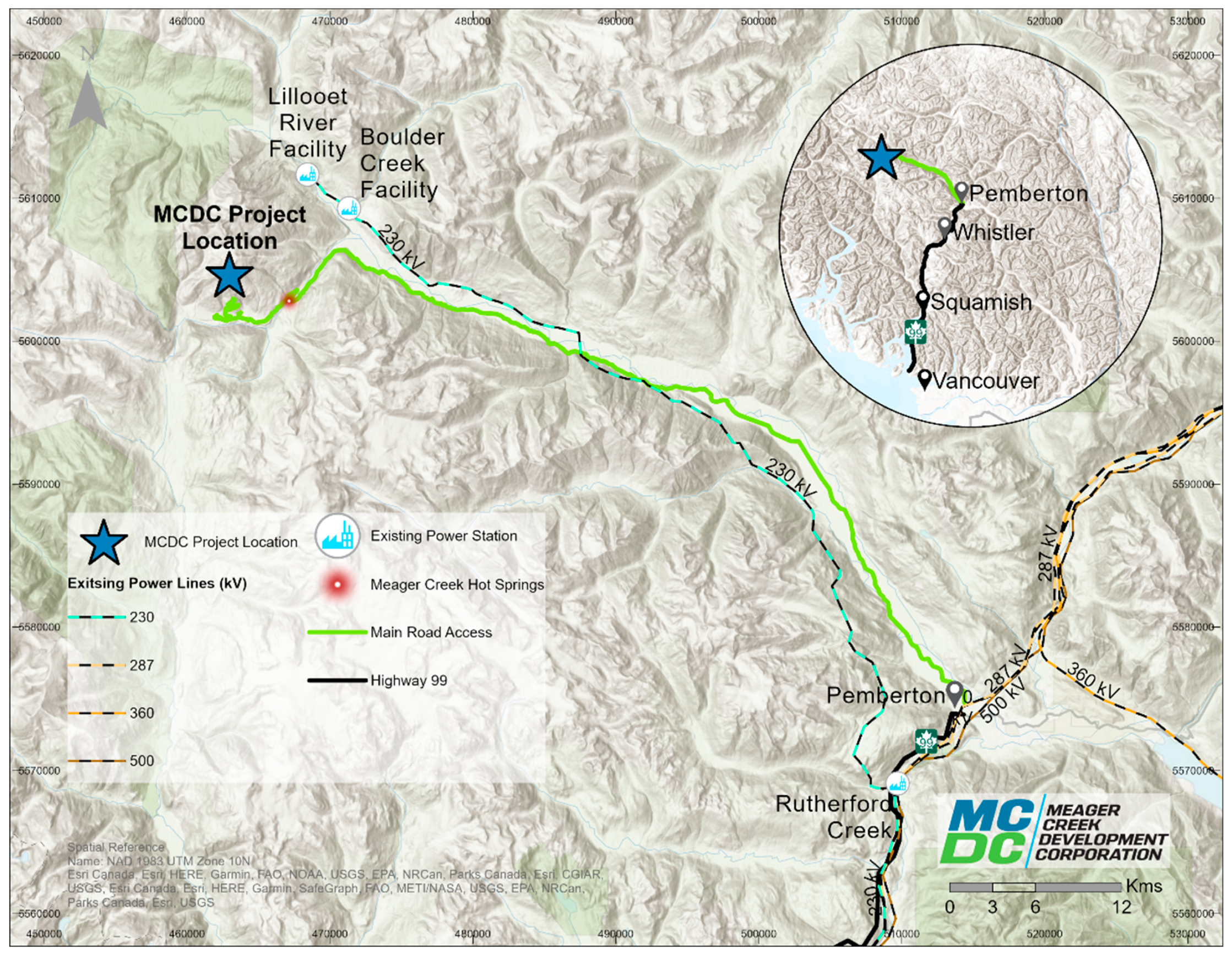



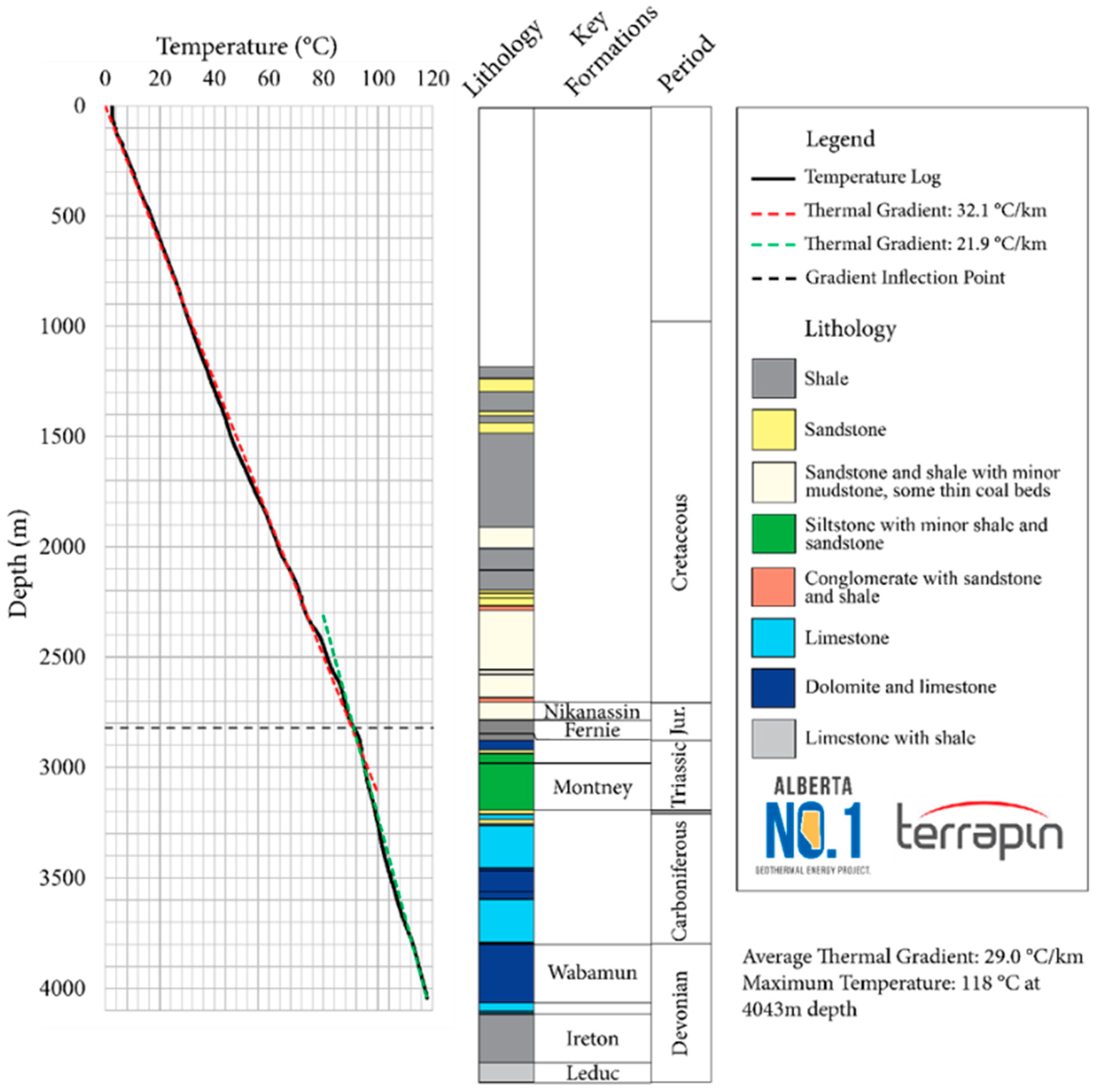
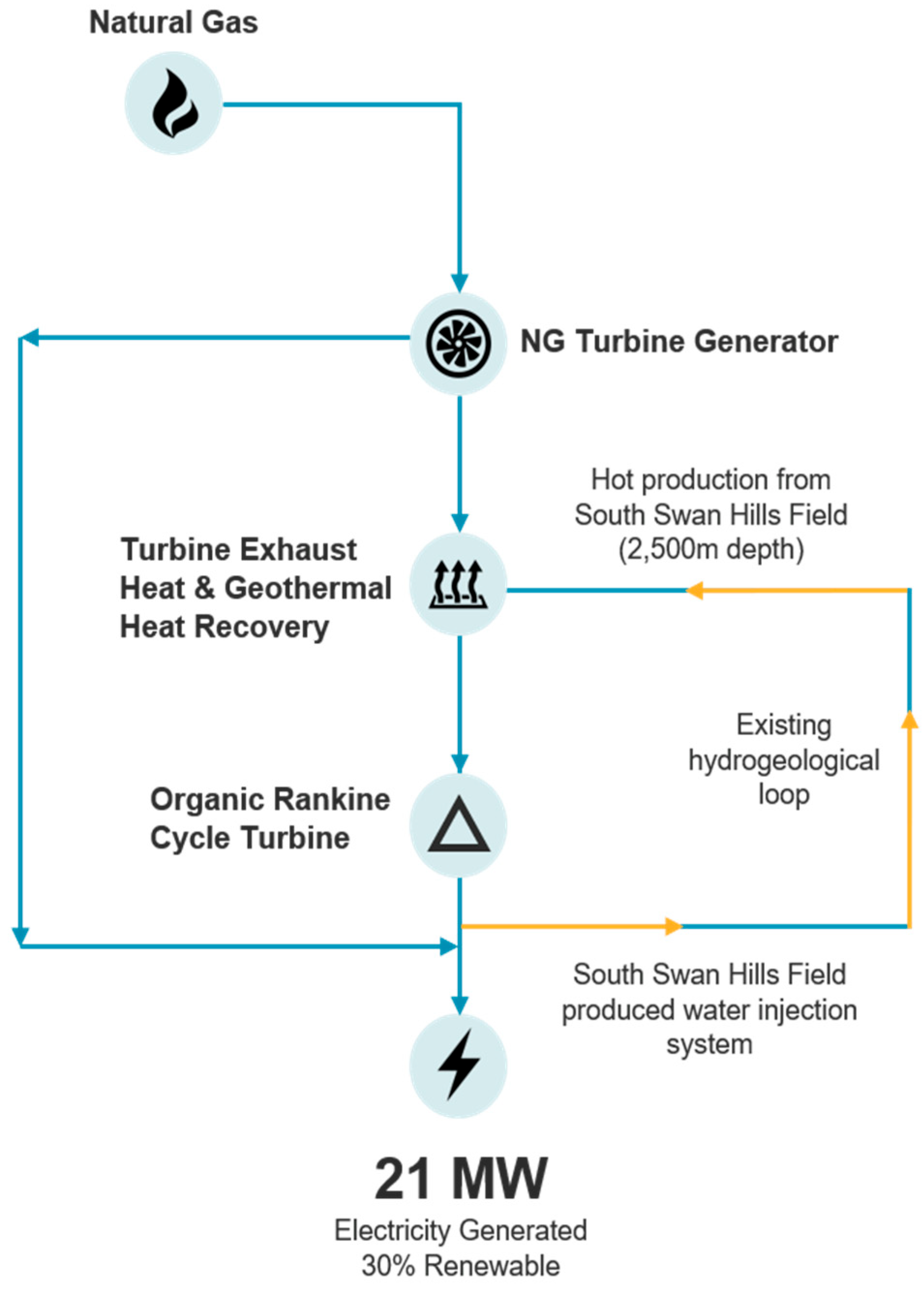



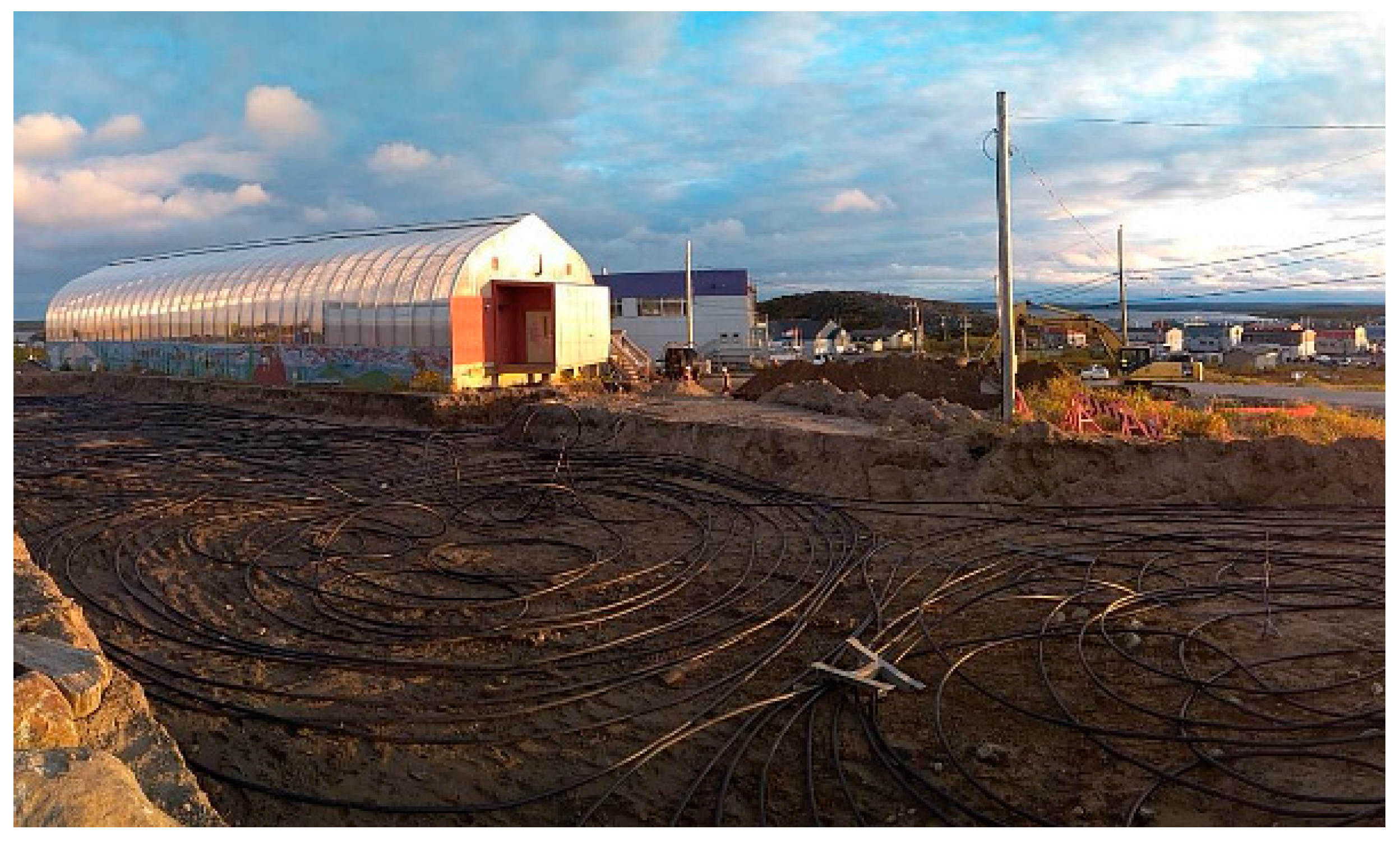


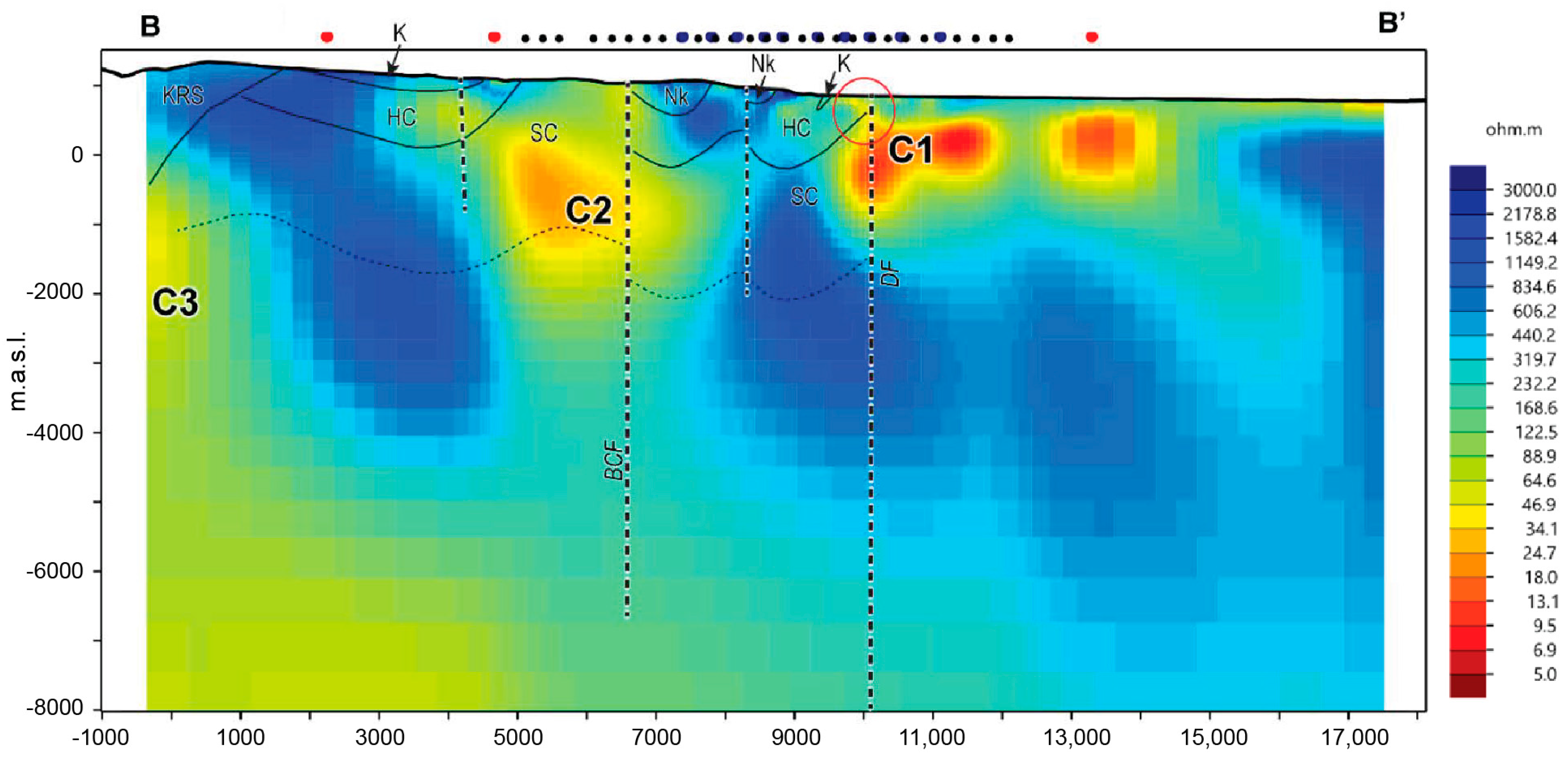


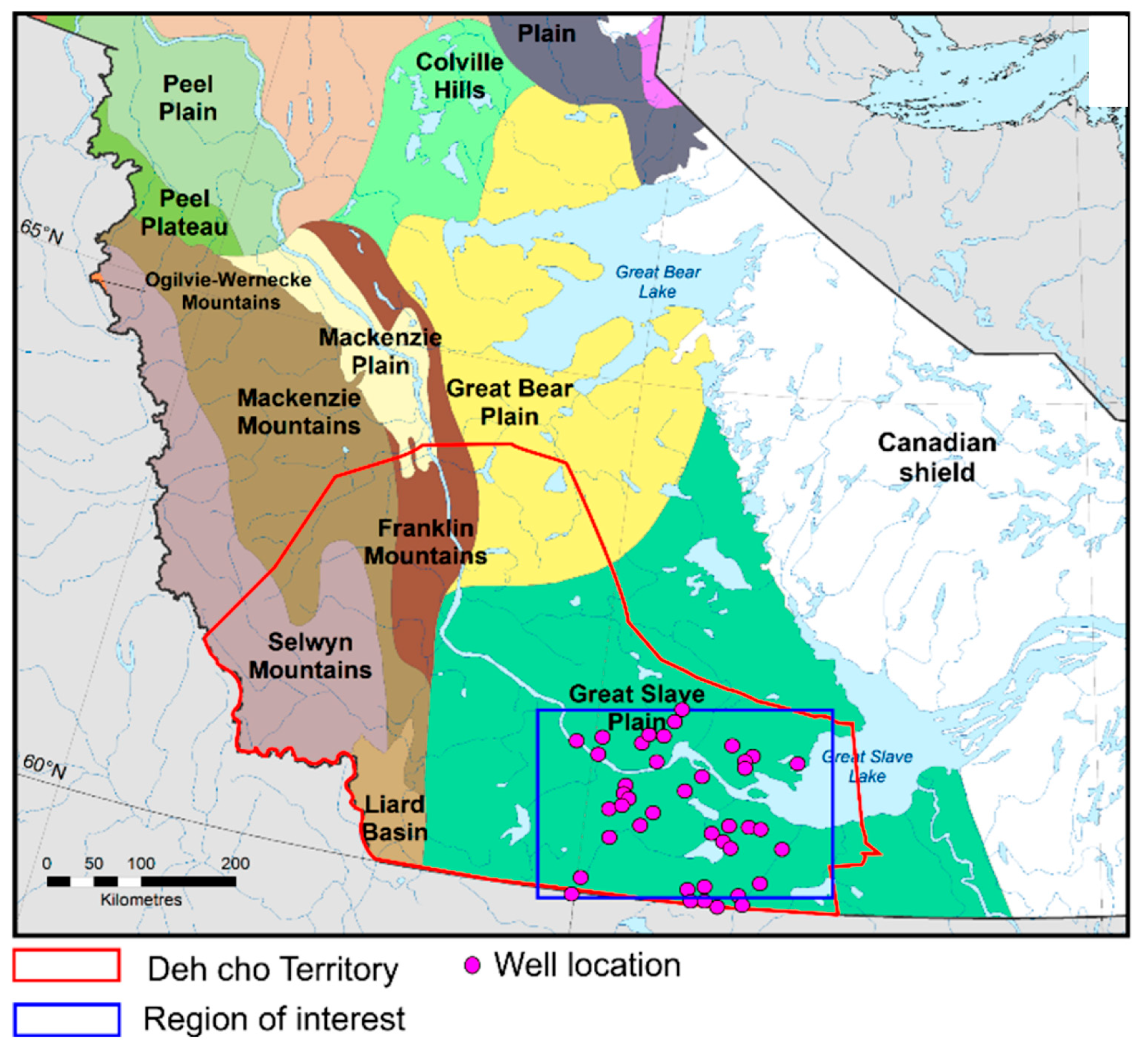
| University | Geothermal Research Program |
|---|---|
| University of Alberta |
|
| University of Calgary |
|
| Institut national de la recherche scientifique (INRS) |
|
| Polytechnique Montreal |
|
| Concordia University |
|
| University of Waterloo |
|
| University of Saskatchewan |
|
| University of Regina |
|
Disclaimer/Publisher’s Note: The statements, opinions and data contained in all publications are solely those of the individual author(s) and contributor(s) and not of MDPI and/or the editor(s). MDPI and/or the editor(s) disclaim responsibility for any injury to people or property resulting from any ideas, methods, instructions or products referred to in the content. |
© 2024 by the authors. Licensee MDPI, Basel, Switzerland. This article is an open access article distributed under the terms and conditions of the Creative Commons Attribution (CC BY) license (https://creativecommons.org/licenses/by/4.0/).
Share and Cite
Huang, K.; Dehghani-Sanij, A.; Hickson, C.; Grasby, S.E.; Smejkal, E.; Miranda, M.M.; Raymond, J.; Fraser, D.; Harbottle, K.; Torres, D.A.; et al. Canada’s Geothermal Energy Update in 2023. Energies 2024, 17, 1807. https://doi.org/10.3390/en17081807
Huang K, Dehghani-Sanij A, Hickson C, Grasby SE, Smejkal E, Miranda MM, Raymond J, Fraser D, Harbottle K, Torres DA, et al. Canada’s Geothermal Energy Update in 2023. Energies. 2024; 17(8):1807. https://doi.org/10.3390/en17081807
Chicago/Turabian StyleHuang, Katherine, Alireza Dehghani-Sanij, Catherine Hickson, Stephen E. Grasby, Emily Smejkal, Mafalda M. Miranda, Jasmin Raymond, Derek Fraser, Kass Harbottle, Daniel Alonso Torres, and et al. 2024. "Canada’s Geothermal Energy Update in 2023" Energies 17, no. 8: 1807. https://doi.org/10.3390/en17081807
APA StyleHuang, K., Dehghani-Sanij, A., Hickson, C., Grasby, S. E., Smejkal, E., Miranda, M. M., Raymond, J., Fraser, D., Harbottle, K., Torres, D. A., Ebell, J., Dixon, J., Olsen, E., Vany, J., Marcia, K., Colpron, M., Wigston, A., Brasnett, G., Unsworth, M., & Harms, P. (2024). Canada’s Geothermal Energy Update in 2023. Energies, 17(8), 1807. https://doi.org/10.3390/en17081807








